AURORA BOREALIS & TUNDRA SWANS: Under the Northern Lights
Article & Photographs by Mina Thevenin
Contributing Writer & Photographer Richard S. Wright, Jr.
AURORA BOREALIS & TUNDRA SWANS: Under the Northern Lights
Twenty years ago in the month of June I saw the Northern Lights. It was near midnight on a clear and starry night as I stood out back of the New Finland St John’s Church in Saskatchewan, Canada- a little country church built by the Finnish immigrants who settled there in 1887. Half of my roots echo the Finish language in those fields of wheat and oats, farmers whose hands of my great grandparents and their young children, my grandparents, joined with the uusi Suomi (New Finland) community to build that very church- the same church I would bury my grandmother in the next day.
So there I stood outside, mosquitoes wanting a bite of me, staring up at that big Saskatchewan night sky. Waiting. Waiting for the Northern Lights to come…
aurora means “dawn” in Latin. In mythology Aurora is the name of the Roman Goddess of the Dawn, (in Greek it is Eos) who is often depicted riding in a horse-drawn chariot across the early morning sky- for which she brings the rising sun. Thus, attached to the celestial elements, Aurora’s family includes Brother Sun and Sister Moon. Though she has had many mortal lovers, rumor has it she was also the lover of the hunter Orion, a constellation in the winter sky that is visible worldwide today(1), she poetically married her god-husband,
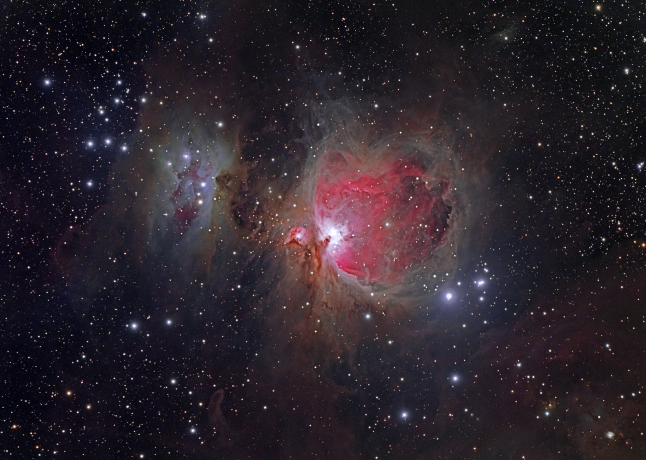
Astraeus of dusk, and together they had children of planets, stars and winds. One of her wind sons is named Boreas. So it is together that Roman mythology’s mother and son, Aurora and Boreas, paint the bright and colorful Northern Lights across the earth’s Arctic sky-canvas of the North Pole. Colors dance and pulsate like flowing ribbons into the night, especially in the colder months, and are aptly named The Northern Lights or Aurora Borealis– for these two artists of the sky.(2)
Actually, the Northern Lights are not their best at geographic North Pole, also known as true north in the Arctic. True North is a geographical position of 90° North latitude- all lines of longitude converge at the pole (3). Aurora Borealis is better seen a little south of it on the ever changing north’s magnetic pole. Why? The aurora borealis circles the earth on an oval path- called the auroral oval. This path is slightly south of geographic true north and circles the earth elliptically. The lights follow an oval rotational area called the earth’s North Magnetic Pole (using a compass shows us magnetic north) and all of this path-flow (for the Northern Lights to be visible and showy) is influenced by several things: solar (sun) flares, the solar wind direction and its wind intensity, and interplanetary magnetism; the auroral oval changes daily due to these factors. Aurora Borealis|Tundra Swans|Northern Lights
So which areas are most likely to see the Northern Lights during the winter season? Alaska, northern parts of Canada, (the Geophysical Institute has a good website for tracking current aurora oval in North America), the southern half of Greenland, Iceland, Northern Norway, Sweden, Finland, and the western half of north Russian (with the Kola Peninsula of Murmansk Oblast and Siberia) are the most likely geographic regions to see the Northern Lights. Nordkapp, or North Cape, is Europe’s northernmost mainland tip and is excellent for Northern Lights. Beyond Nordkapp is Svalbard, a group of islands in the Atlantic, which is Europe’s northernmost off-mainland tip and is often an expedition starting point if you are going to the North Pole, but it is a little too far north to see the aurora borealis with any certainty- especially if the geomagnetic activity is high. Svalbard does, however, have a showy Northern Lights display if the geomagnetic activity is low.
But what about those who will never trek to the uppermost regions of the earth’s northern magnetic hemisphere? Is there opportunity to still see the Northern Lights? Yes. Sometimes when the aurora oval extends further south due to increased solar storms that interact more with the earth’s magnetic fields, the Northern Lights are seen south beyond their normal elliptical range. Areas of central and southern Scandinavia see a shorter season of lights. North-central United States and Scotland also occasionally see the Northern Lights. (4)
KP-index Aurora Borealis|Tundra Swans|Northern Lights
KP-Index measures the global geomagnetic storm, is a quick reference guide that gives a rating from 0 to 9. If the KP is nearer “9”, there is better likelihood of seeing the Northern Lights, if nights are clear. (5) When PHOTOGRAPHY WORLD’s photographer Richard S. Wright, Jr. was shooting the Aurora Borealis in March, the KP-index reached a 4.
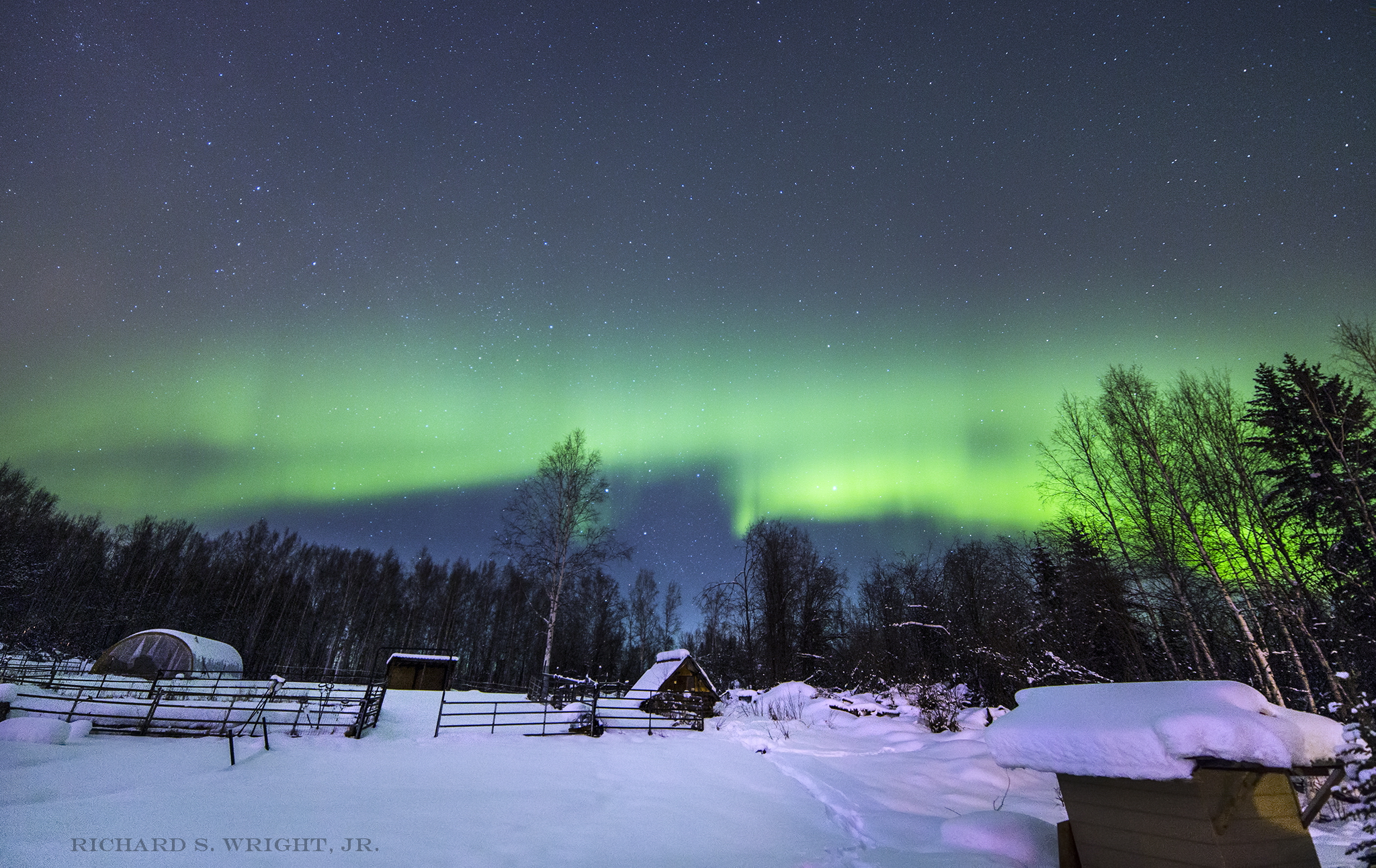
Richard shot these images in Fairbanks, Alaska, with a Canon 6D, two lenses: the Rokinon 14mm f/2.8 prime lens and a Canon 24-105L f/4 zoom, and tripod. Settings: manual, ISO 3200 for 10 seconds, and a 10 second delayed timer with mirror lock- so the actual shutter opens 10 seconds after the mirror flips up.
“The curtains were a wonder to behold. The challenge is to expose long enough, but they are moving too, so you can’t go too long…the aurora are a moving target and you want your exposures to be as short as you can get away with.” -Photographer Richard S. Wright, Jr.
Note the colorful reflective lights from the Aurora Borealis- cast onto the snow. Temperature was -25 Fahrenheit or -31.7 Celsius.
“I liked the way the lines interacted between ground and sky, and the dark foreground against the sky show lends to the mystery. The Pleaides star cluster makes a guest appearance at the left.” -Photographer Richard S. Wright, Jr. (below)
“Fairbanks Alaska is an excellent, and somewhat underrated Aurora destination. In the winter time when the days are short Fairbanks is not as glamorous as Iceland or northern Europe, but it is vastly more affordable and accessible for North Americans. [Finland is the least expensive place in Europe for a visitor Aurora destination.] Be advised, too, that Fairbanks is a sleepy little town in the winter; in fact a good portion of Alaska’s tourism trade is simply boarded up for the winter… It is, however, for the quiet soul, a supremely beautiful and tranquil place to spend a week in the deep winter time.
There will be snow, cold, and icy roads… rent a car with four wheel drive and good tires and you’ll be set! We stayed at the very rustic and authentic Alaska Grizzly Lodge, which is just north of Fairbanks proper. On my first visit to Alaska I discovered this lodge by accident on a summer camping trip when my two sons and I emerged from the wild bedraggled and in much need of a clean bed and a shower. Anita Tomsha, the proprietor told me about how busy she was in the winter time with Japanese tourists coming over to see the Aurora and I made a mental note that I made good on this next trip to Alaska.” -Photographer Richard S. Wright, Jr., from the Accidental Astronomer. (6) Aurora Borealis|Tundra Swans|Northern Lights
While Wright was in Fairbanks, Alaska photographing the Northern Lights, I was at the longitudinal opposite end of North America photographing another Arctic beauty, the Tundra Swan.
Aurora Borealis|Tundra Swans|Northern Lights
Under the Northern Lights
on the east coast’s Chesapeake Bay there winter’s (because it is warmer than the Arctic’s Tundra winter), the Tundra Swan.
Fairy tales of old Russian and Germanic folklore, among other histories, tell the stories of hunters and swans, but as we can anticipate- they are not really swans. Spells have been cast upon maidens and turned them into swans. Sound familiar? In 1875 the great Russian composer, Tchaikovsky, Чайковский, (pronounced chy-KAWF-skee) was commissioned to compose the music for what has become one of the most beloved ballets, Swan Lake.
I take liberties when I ask, did Aurora’s mortal lover, the great hunter Orion, also see the maiden-swan- for whom he might have fallen in love with had it not been for Aurora’s grand and commanding dawn every morning, for which she never fails us?
In the early mornings after dawn, in zero temperatures, -18 c, and wind warnings, I crunched through snow along the frozen shores of the Chesapeake Bay to find the “wintering” flocks of tundra swans. Unlike Russia’s mute swans (orange bill and legs), which Tchaikovsky probably envisioned for the ballet, the tundra swan (black bill and legs) summers and breeds in the Arctic’s northern tundra region, hence its name- Tundra Swan.
Only within the last twenty years has science begun to study the North American Tundra Swan, once called the Whistling Swan. They are monogamous in mating and it is believed they spend their entire adult lives together as a pair.
Their breeding season begins towards the end of May on the Arctic’s tundra wetlands during the summer when it is warmer and average temperatures range from 40 to 50 f (4.4-10 c) (7). During a time when the sun “never” sets- that’s 6 to 10 weeks of “the land of the midnight sun”, the tundra swan mate and nest. Then as the Arctic weather turns colder near the end of September, the swans fly south for their nonbreeding season of winter; swans that are even two to three months old are able to fly with their parents and flocks for winter migration. They arrive at their winter homes- shallow estuaries, freshwater lakes, ponds and rivers on the east and west coasts of the United States about mid-October to mid-December. Some banded flocks are observed to remain in the Great Lakes regions and do not migrate to the coastal regions. Like many birds, the tundra swan tend to revisit the same summer and winter home territories yearly. (8)
During the week of photographing the swans in February, the Chesapeake Bay went through a freezing and thawing process, none of which seemed to affect the flock of birds which stayed on the ice/water at all times.The wild flock numbered twenty-five consistently and the number of juveniles (cygnets) appeared to outnumber the mature birds. None of the swans were banded. Studies indicate that flocks are composed of multiple family groups and can number more than 100 individuals. The swans fly in V-formations at altitudes of 1,800 to 4,500 feet and higher. (9)
Mated Pairs & Their Young
Aurora Borealis|Tundra Swans|Northern Lights
Many “couples” were observed being close to one another in proximity, whether they were sleeping (always on the ice or water) or they were feeding together. Many of the mated pairs of swans had cygnets (young swans born the previous summer, June) with them- identified by being slightly gray and smaller; the cygnets and parents generally spend the first year together until the cygnet is ready to mate after the return trip to the tundra the following year (age one).
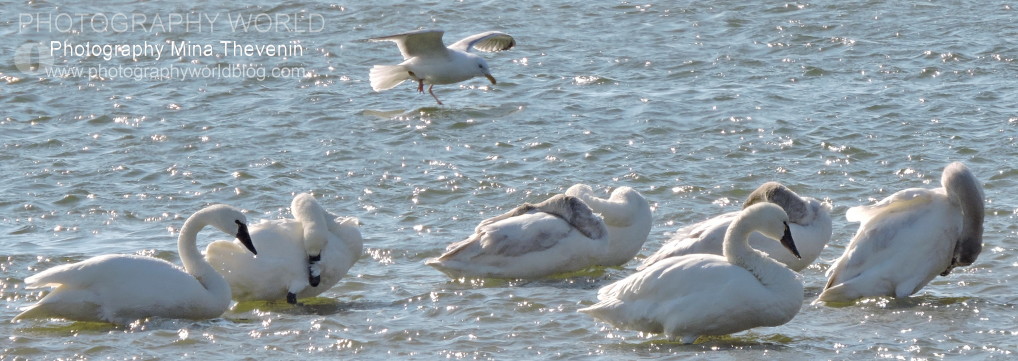
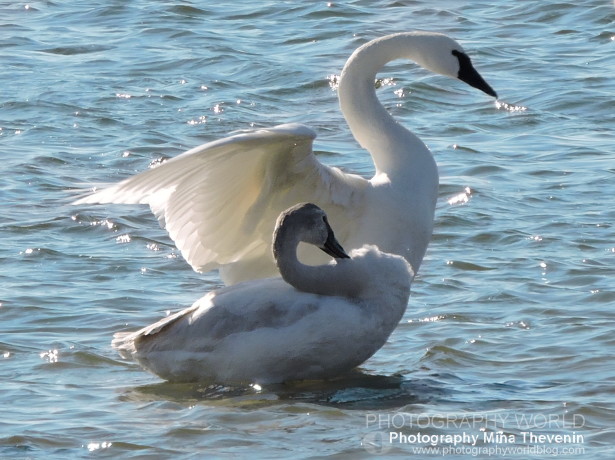
Tundra Swans are large birds with a wingspan of nearly five and a half feet, or 1.67 meters. Adults can typically weigh up to 20 pounds, 9.07 kilograms; males weigh slightly more than females. They are distinguished from a similar looking swan, the Trumpeter Swan, by an easy telling and exacting difference-
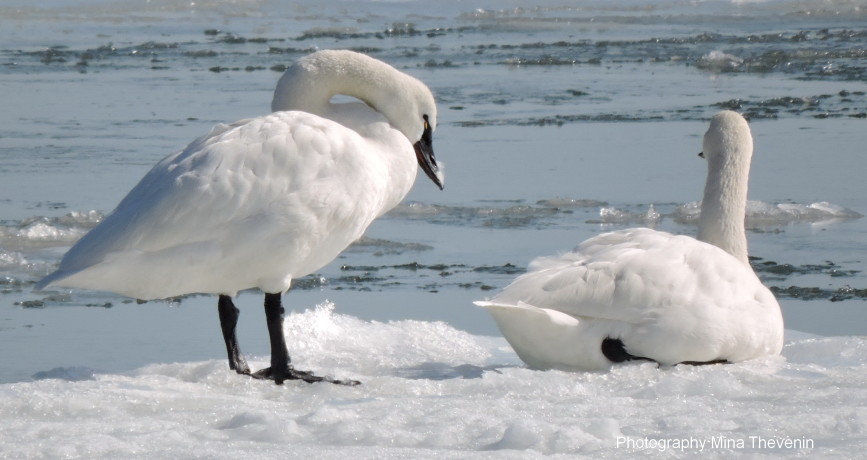 a yellow mark on the black bill just below either of their eyes. Cygnets’ yellow mark becomes more pronounced as they near adulthood.
a yellow mark on the black bill just below either of their eyes. Cygnets’ yellow mark becomes more pronounced as they near adulthood.
The Chesapeake Bay has some of the tundra swan’s favorite aquatic foods- the redhead grass, widgeon grass and sago pondweed. Because their food is underwater, the swans tip their bottoms upward as they plunge their heads into the shallows to pluck the aquatic grasses. Observed were gulls, often within the flock, waiting for floating pieces of the delectable grasses- for which they were none too shy to assert themselves with the larger tundra swans. Unfortunately, and through no fault of their own, many swans have begun eating farmers’ field grains and winter wheat (10) due to diminished aquatic vegetations because of poor water quality. This has been causing a problem for crops. The good news is that currently there are now programs underway to ensure a renewed healthy water system within the Chesapeake Bay and its watersheds to support such wildlife as the beautiful tundra swans.
20 Years Ago…
Many of the tundra swans return to their Arctic home year after year and for some- twenty years have been recorded for many birds. They must surely experience the dancing colors above them- moving like ribbons across the sky. Colors of reds, greens, purples, yellows, blues, and cobalt blues…and whites….
Twenty years ago in the month of June I saw the Northern Lights in that great Saskatchewan sky, a time when many of these long-living swans from Chesapeake Bay winter-home were perhaps just first born on the Arctic tundra. I recall, as I stood looking into the starry night, that I saw faint lights in the distance- glowing, undulating between the stars and me like a vapor that shouldn’t be. Everyone told me there would not be a showing of Northern Lights, that it wasn’t the right time of year, but I waited outside anyway- watching the mist dance ever closer above me.
When I knew for sure my eyes did not deceive me, I yelled for my family to come quickly outside and see! For an hour or more, that June of 1995, I experienced a ballet of Swan Lake white ribbons dance above me as I lay stretched out on the cool grass under the Northern Lights that shouldn’t be. But came anyway.
Poetry & Art Credits
Bush, Reid. “Kind Man.” What You Know. Monterey, Kentucky: Larkspur Press, 2004. 69. Print. Thevenin, Nicholas. The Northern Lights (Honorary Title). Hammering (Original Title). 2002
ABOUT AUTHOR & PHOTOGRAPHER | MINA THEVENIN
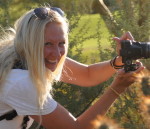
Mina Thevenin is Executive Editor, writer & photographer at Photography World, Ltd Co, online publication. Additionally, she is owner of www.kentuckianacounseling.com and has worked in the fields of therapy and wellness since 1989. Mina Thevenin is a philanthropist who supports education & preservation in the fields of global humanity and nature.
Photographing Northern Lights, or Aurora Borealis, preserves the night sky paintings & its pulsating ribbons of dancing colors. It is a free show for all to see and experience, tales of never-ending stories with each passing moment. Though not alone, the legendary artists are Aurora and her son Boreas who paint the bright and colorful Northern Lights across the earth’s Arctic sky-canvas of the North Pole.
But is the show truly free?
We thrive upon the natural beauty in the world. Our inter-dependency of humans and ecosystem is a delicate balance of which we are entrusted. Our opportunities to engage with others in this understanding allows for a greater likelihood of furthering the world in which we live- that our children, grandchildren, great grandchildren, and a millennium of world wide web interconnections, thrives. Earth’s natural beauty gifts us by helping us to survive. We are emotionally and spiritually renewed in her ever changing paintings. We are, after all, co-artists in care.
About Photographer | Richard S. Wright, Jr.
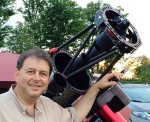 Richard S. Wright Jr. is a Senior Software Developer for Software Bisque (www.bisque.com), a leader in astronomy hardware and software products for professional and serious amateur astronomers. His astrophotography blog can be found at www.eveningshow.com/AccidentalAstro, and his image gallery at www.eveningshow.com
Richard S. Wright Jr. is a Senior Software Developer for Software Bisque (www.bisque.com), a leader in astronomy hardware and software products for professional and serious amateur astronomers. His astrophotography blog can be found at www.eveningshow.com/AccidentalAstro, and his image gallery at www.eveningshow.com
********
(1) Zimmerman, Kim Ann. (19 July, 2012.) Orion Constellation: Facts About the Hunter WEBSITE
(2) 1911 Encyclopædia Britannica/Aurora (goddess) WEBSITE
(3) Rosenburg, Matt. “North Pole:The Geographic North Pole Lies at 90 Degree Latitude”. http://geography.about.com/od/learnabouttheearth/a/northpole.htm WEBSITE
(4) Service Aurora: Best Places to see the Northern Lights? WEBSITE
(5) KP-Index as a Global Aurora Indicator. SpaceWeatherLive.com WEBSITE
(6) Wright, Jr., Richard S. “Shooting the Aurora” (March 17, 2015), The Accidental Astronomer WEBSITE
(7) Tundra Climate WEBSITE
(8) Fergus, Chuck. “Tundra Swan.” (pdf). Pennsylvania Game Commission. WEBSITE
(9) Ibid.
(10) Tundra Swan. Chesapeake Bay Program WEBSITE
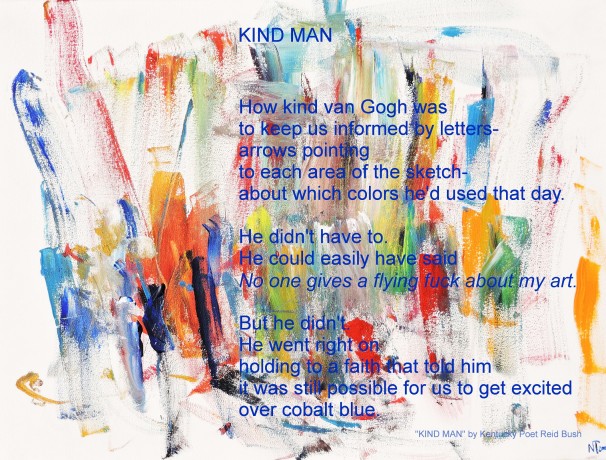

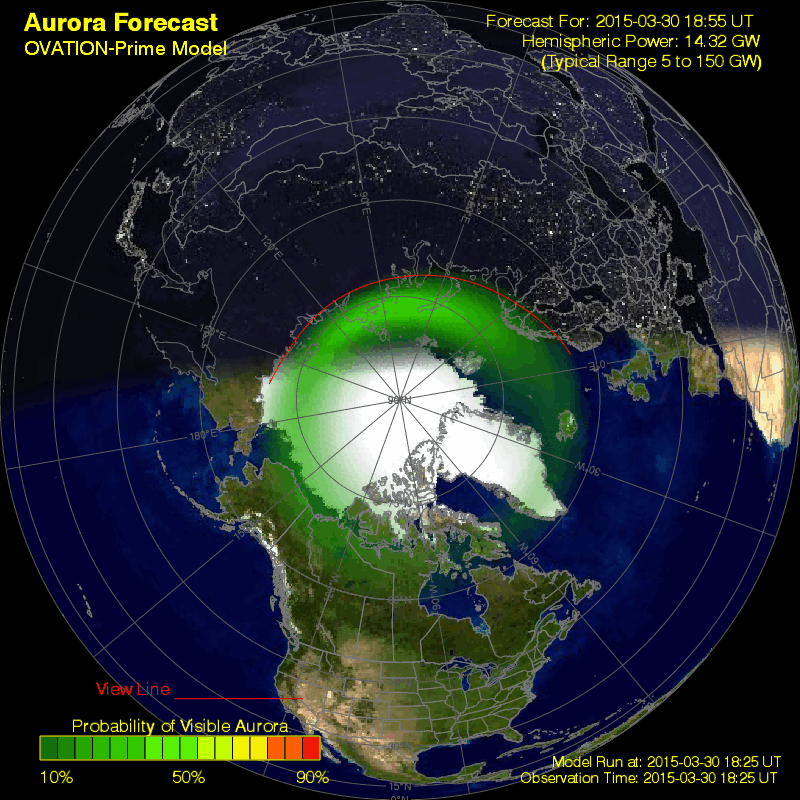

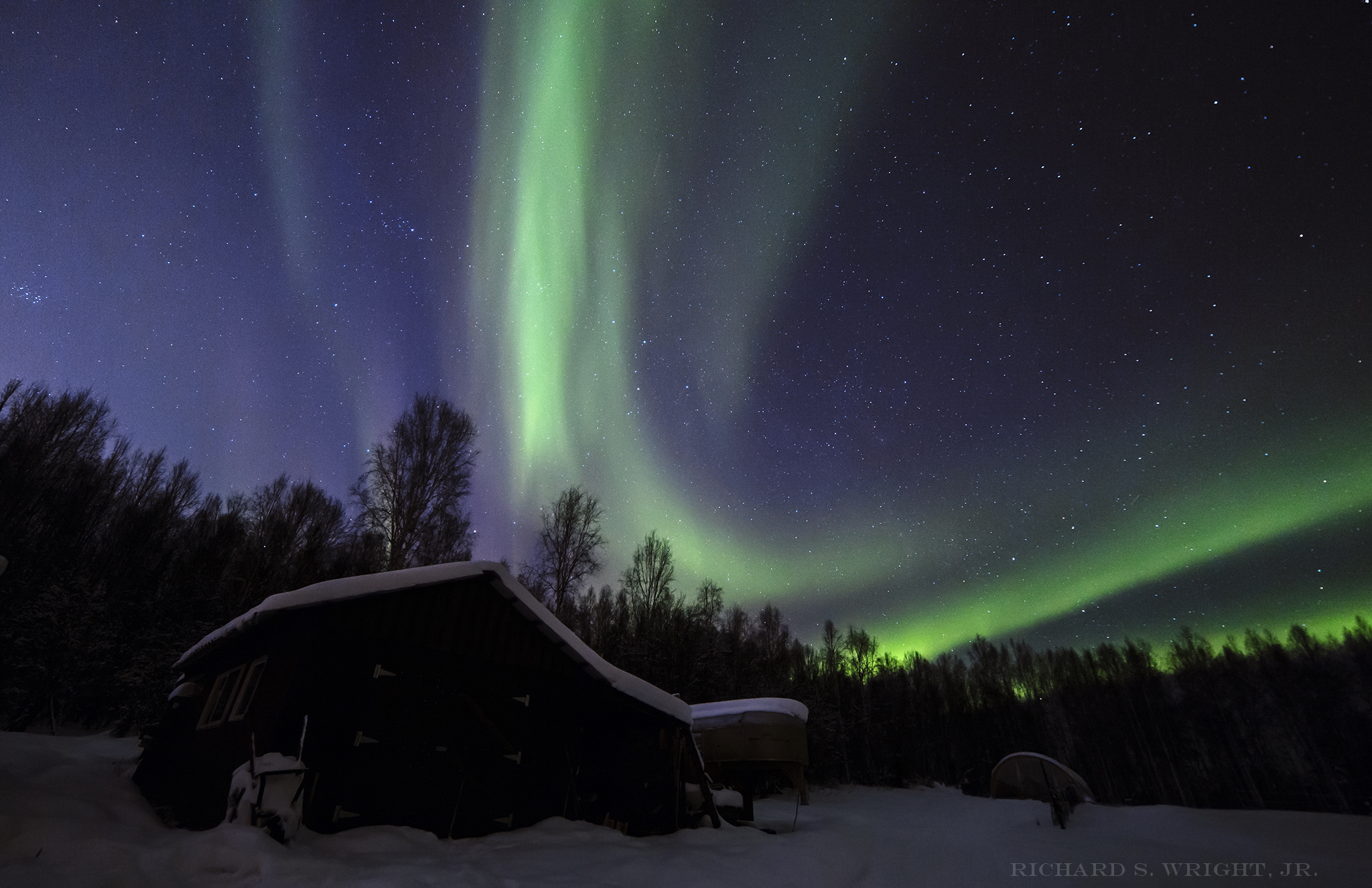

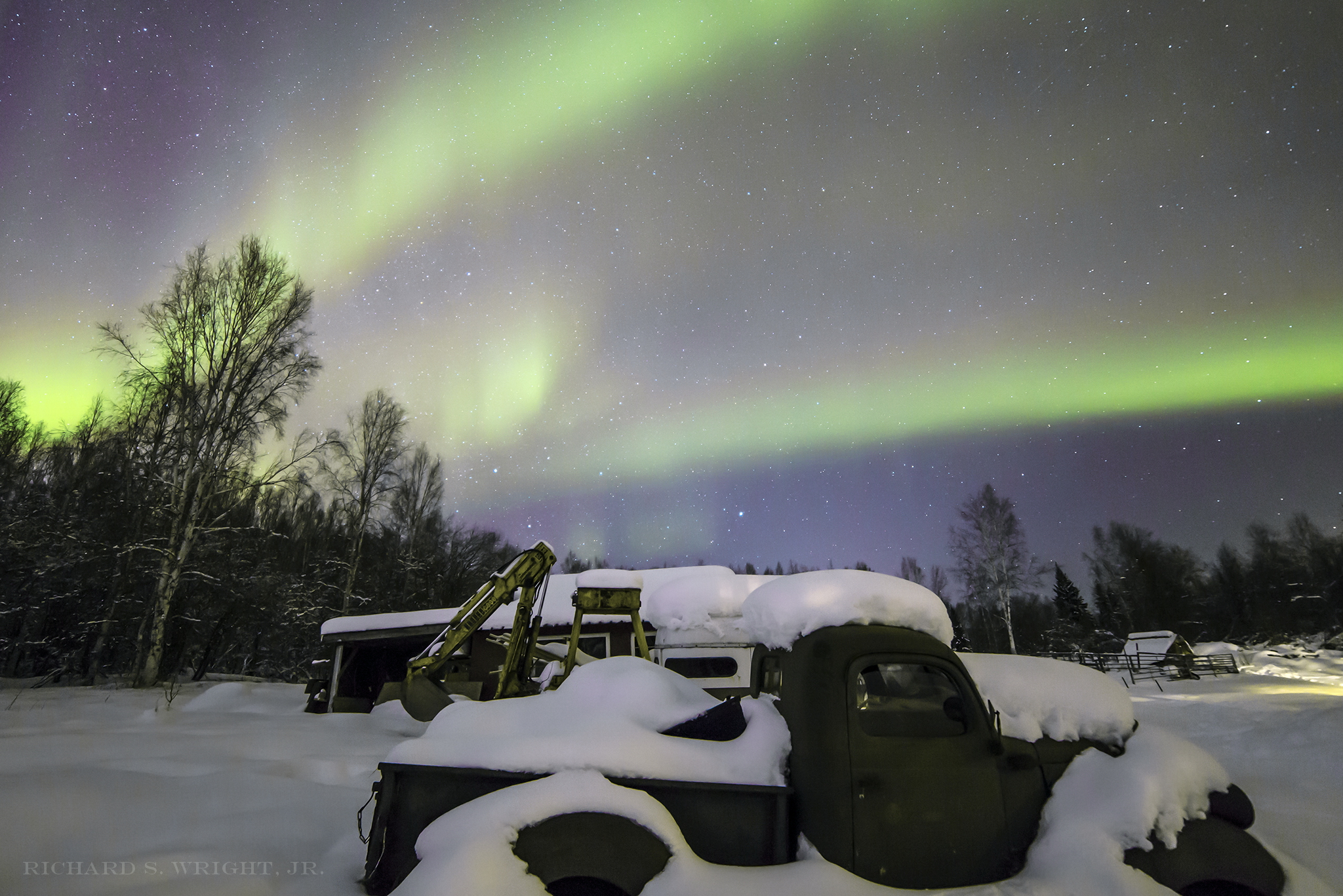

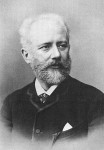
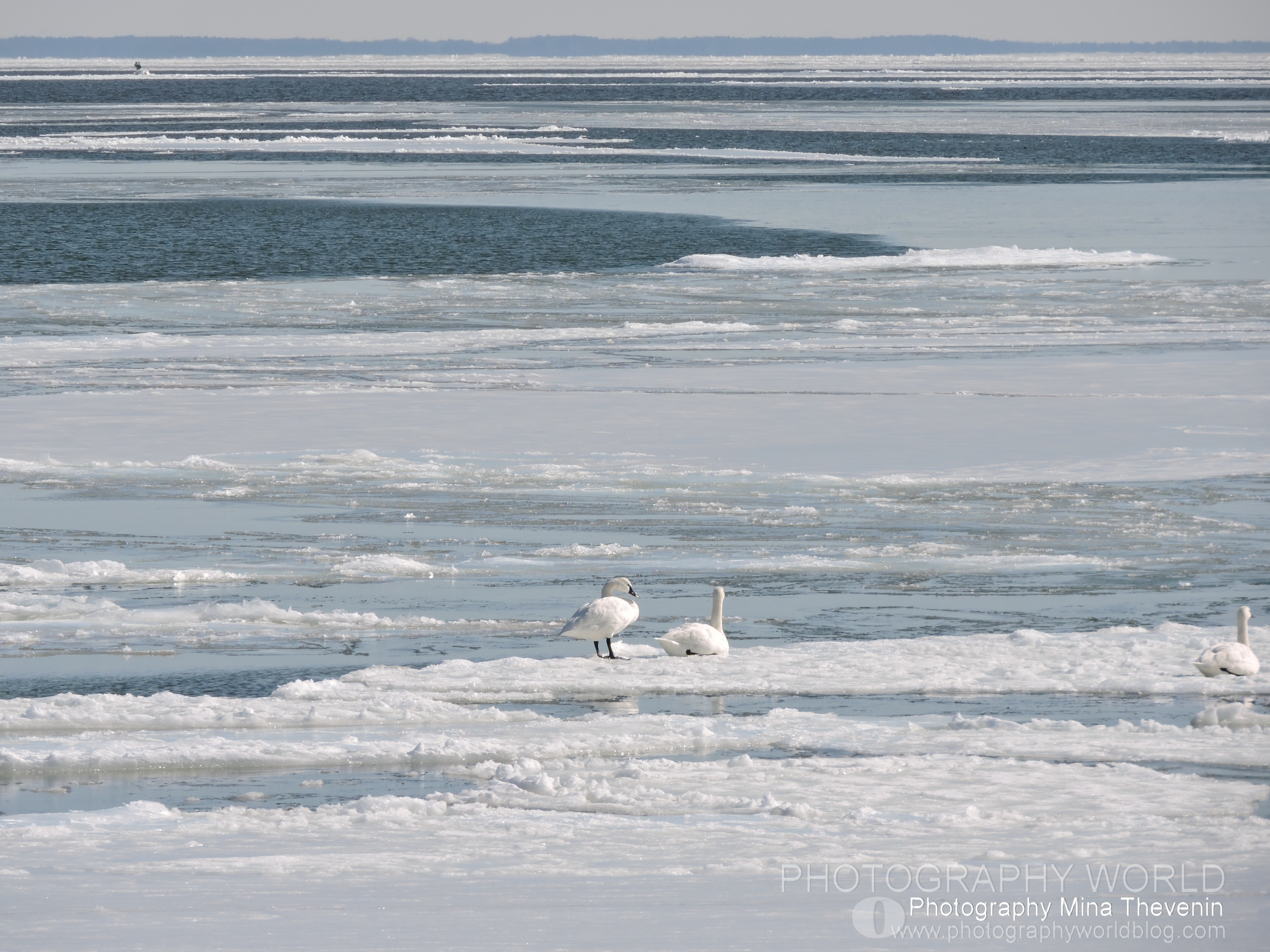
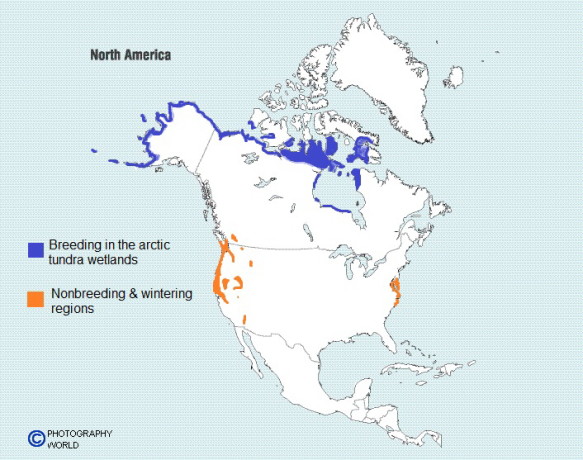
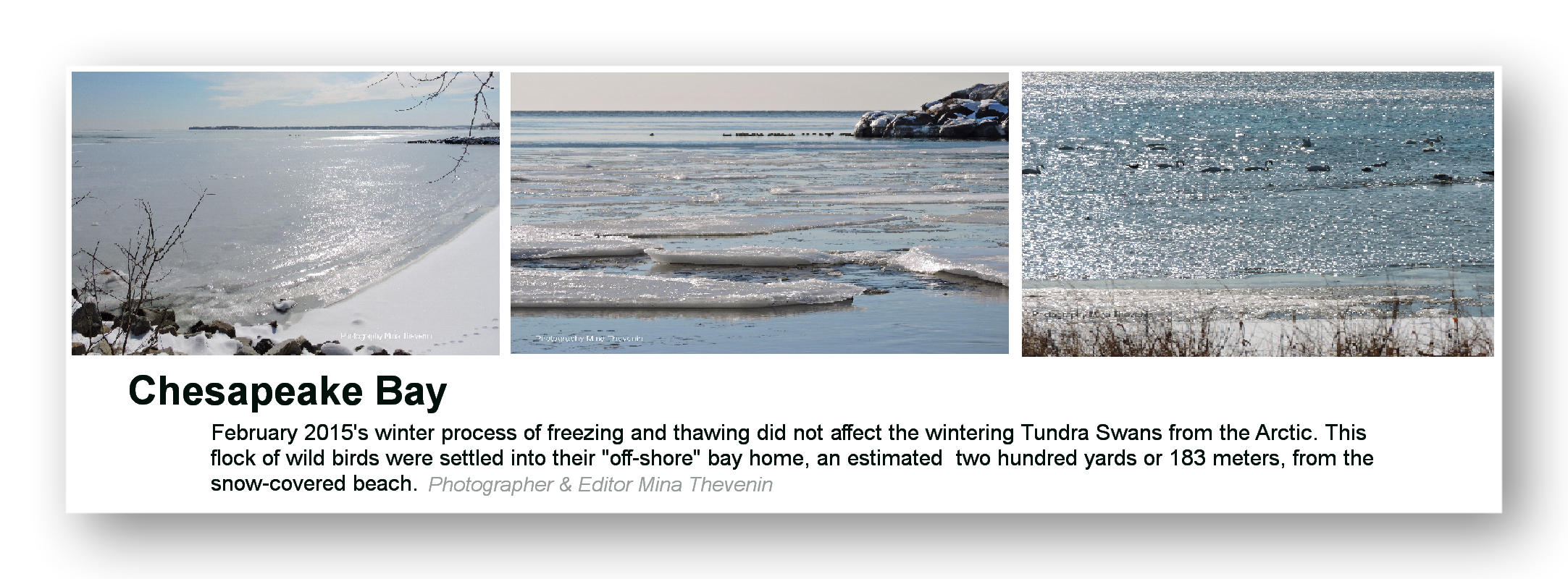
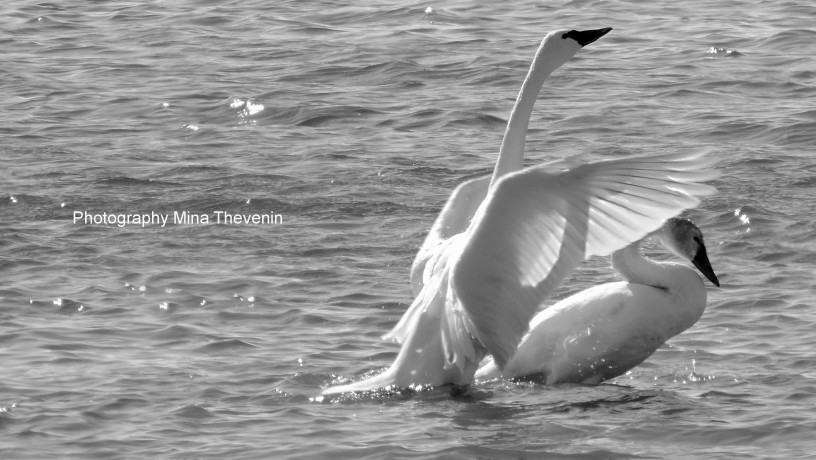
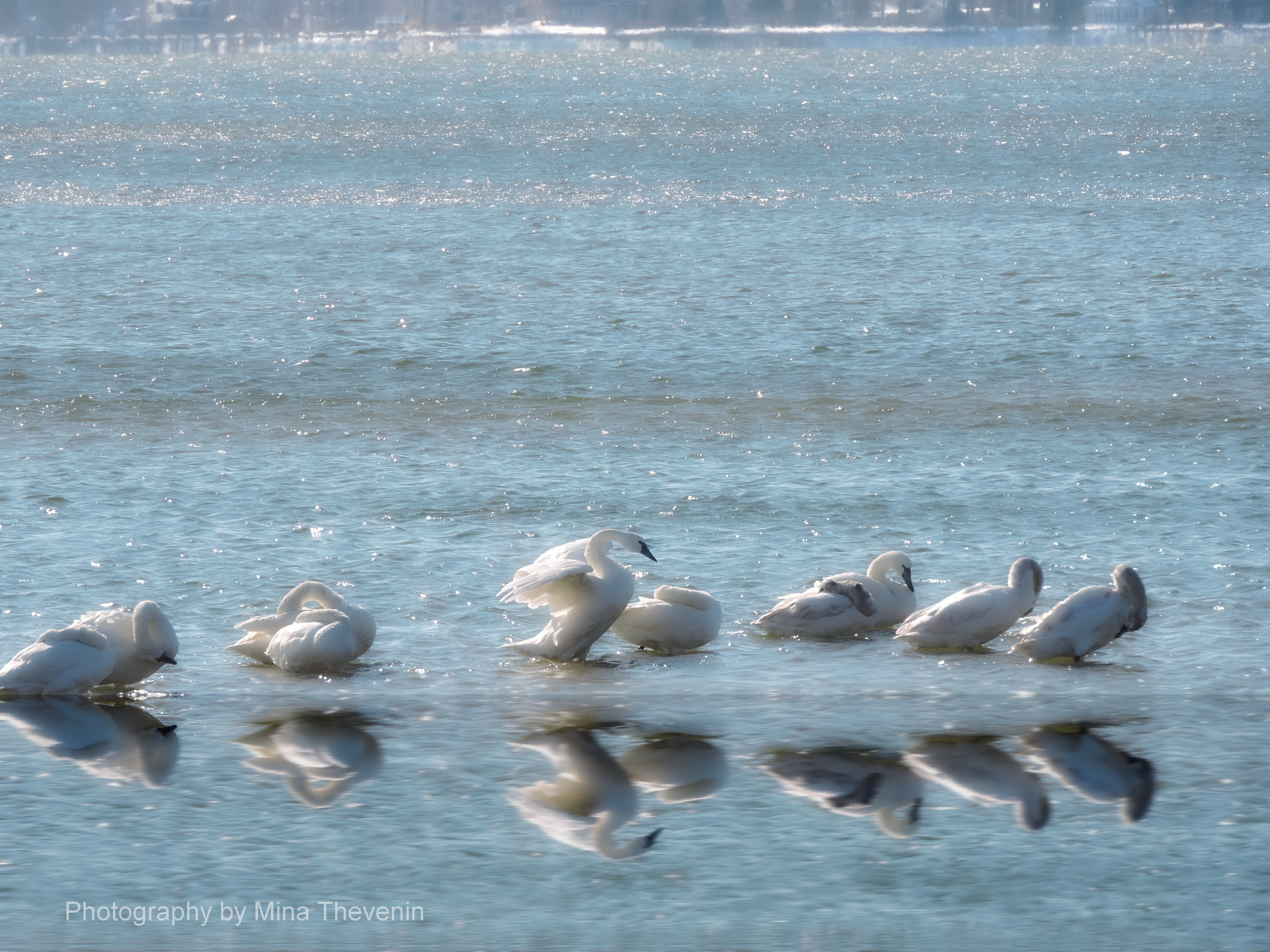
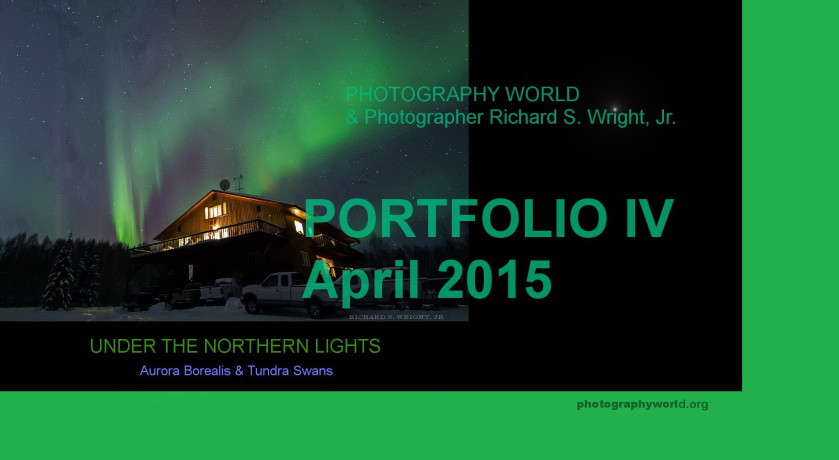
Fantastic web site.
Thank you Darcey!